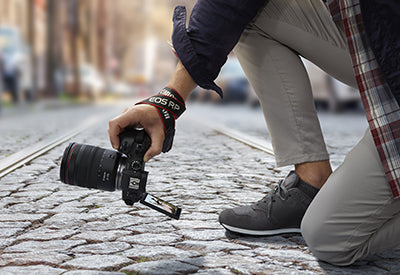
Canon has just doubled their full-frame mirrorless offering with the unveiling of the EOS RP, touted as Canon's smallest full-frame EOS camera to date.
The EOS RP serves as an introductory camera, complimenting its larger brother the EOS R. Both cameras utilize Canon's newest 54mm diameter RF lens mount, DIGIC 8 processor, and Dual Pixel CMOS AF focusing system. What that means is that the lenses you use on the EOS R are all compatible with the RP, as well as Canon's EF-EOS R adapter, giving you access to all of Canon's EF lenses and extenders, without any loss of functionality, light-gathering, or sharpness.
Both cameras also feature Canon's Vari-Angle touchscreen, which is fully articulated with a swivel joint, and the RP features a 2.36 million dot Electronic Viewfinder, all with adjustable brightness settings.
Canon EOS R vs. RP
The primary differences between the EOS R and RP are a result of the RP's smaller form factor and price tag.
Features and Price Tag
First off, the EOS RP is $1,299.00, versus the EOS R's $2,299.00 price tag. That price indicates Canon's intention for the smaller RP—a lightweight mirrorless camera with all of the capabilities of a full-frame.
As a result, the RP is lighter on features and megapixels than the EOS R.
Specifically, the EOS RP features a 26.2-megapixel sensor, comparable to the 6D Mark II, whereas the EOS R's 30.3 MP is closer to the 5D Mark IV (30.4MP). The EOS R also offers a faster frames-per-second (8fps) than the EOS RP (5fps)
Here's the comparison between the R and RP in terms of focusing capabilities: the EOS R has 5655 manually selectable focus points, versus 4779 on the EOS RP. This gives the EOS R the edge in focusing precision, but both utilize Canon's impressive Dual-Pixel CMOS AF system.
The RP does not include a top-side LCD screen to indicate camera settings and modes, though all of that information is visible on the EVF. The RP does feature a mode-dial with Scene Mode presets such as Children, Groups, Astro, and Food, that will emphasize certain settings to best capture specific situations (high shutter speed for children, macro settings for food, etc.)
The R has a faster shutter speed of 1/8,000 compared to the RP's still-impressive 1/4,000.
The smaller RP utilizes Canon's lower capacity LP-E17 battery, which is rated for approx. 270 shots on a single charge. This rating is for comparison purposes only and does not reflect real-world results. The EOS R, for example, is rated for 560 shots on a single charge, but the real-world results can be higher, depending on different settings and conditions.
The smaller form factor and lighter battery result in less weight overall. The EOS RP with a battery weighs in at 1.07lbs, compared to the EOS R with a battery at 1.46lbs. Some may prefer a larger body, so Canon is releasing extension grips for the RP in three different colors - red, blue and black.
The portability and affordability of the EOS RP are a huge plus, without sacrificing the tech and lens system that sets Canon apart. Are you going to be picking one up? Let us know your thoughts on this new mirrorless camera in the comments!
Check out some of the sample images Canon has provided to demonstrate what the EOS RP is capable of.




